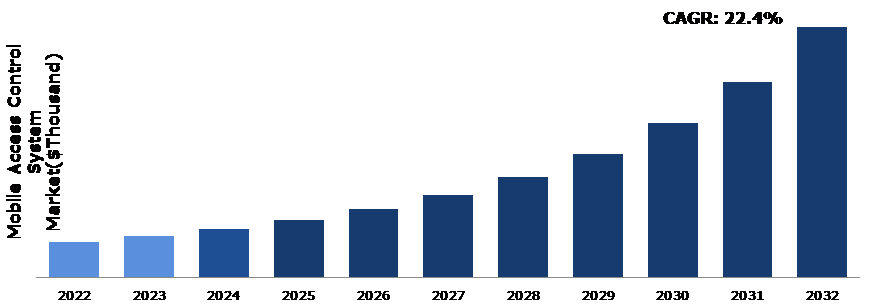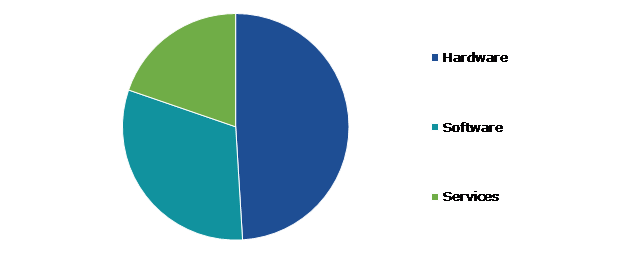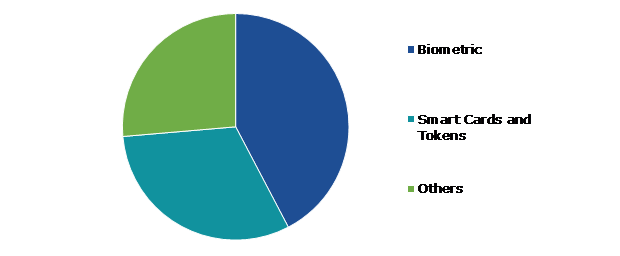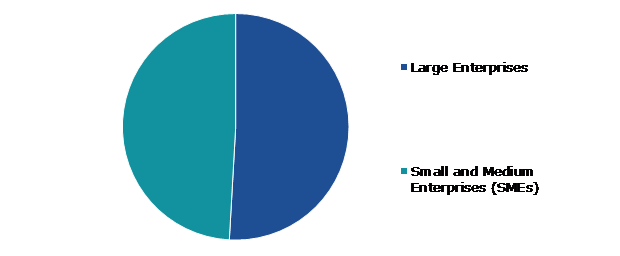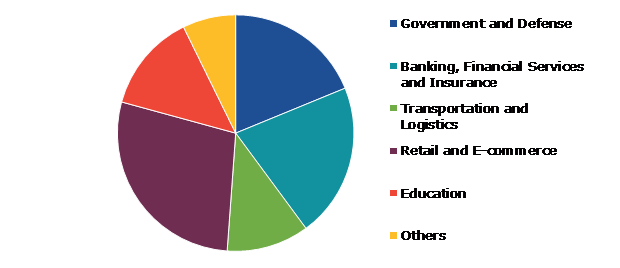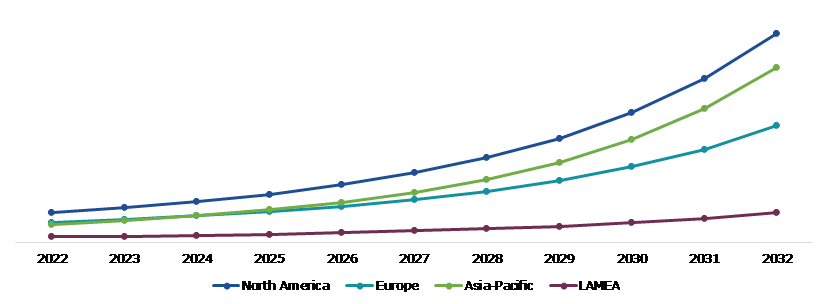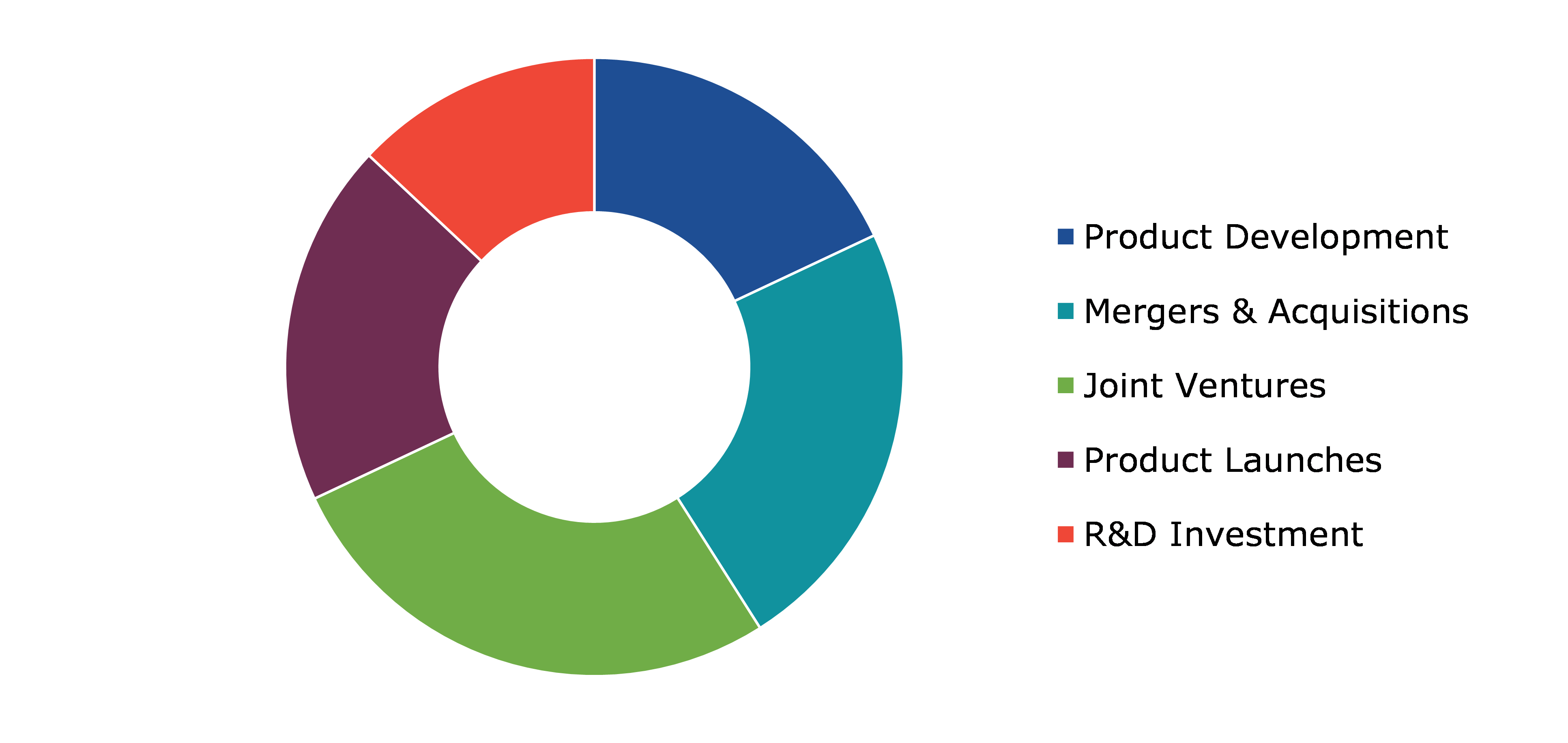Mobile Access Control System Market Report
RA09225
Mobile Access Control System Market by Component (Hardware, Software, and Services), Type (Biometric, Smart Cards & Tokens, and Others), Organization Size (Large Enterprises, and Small and Medium Enterprises (SMEs)), End-user (Government & Defense, Banking, Financial Services and Insurance, Transportation & Logistics, Retail & E-commerce, Education, and Others), and Region (North America, Europe, Asia-Pacific, and LAMEA): Global Opportunity Analysis and Industry Forecast, 2023-2032
Mobile Access Control System Overview
A Mobile Access Control System (MACS) is a cutting-edge security solution that leverages mobile devices to enhance access management. It replaces traditional key cards or fobs with digital credentials stored on smartphones, offering convenient, secure, and flexible access to physical spaces. MACS utilizes technologies like Near Field Communication (NFC) or Bluetooth, allowing users to gain entry by simply presenting their mobile devices to readers. The system's software integrates advanced functionalities such as biometric recognition, real-time monitoring, and remote access management. This not only improves security but also aligns with the increasing digitization of enterprises.
Global Mobile Access Control System Market Analysis
The global mobile access control system market size was $228,690.0 thousand in 2022 and is predicted to grow with a CAGR of 22.4%, by generating a revenue of $ 1,638,455.4 thousand by 2032.
Source: Research Dive Analysis
COVID-19 Impact on the Global Mobile Access Control System Market
Mobile access control system enhances safety by enabling contactless access through mobile devices. Utilizing this technology during the pandemic, ensured secure entry, minimizing physical contact and potential virus transmission. Users could authenticate their identity via smartphones, reducing the risk of infection spread. This innovative solution promoted a safer environment in public spaces, workplaces, and events, aligning with global health protocols.
In the post-COVID-19 period, the mobile access control system emerges as a crucial solution, ensuring secure and contactless entry. By leveraging mobile technology, it minimizes physical touchpoints, enhancing safety in diverse environments. This innovative system seamlessly integrates with smartphones, providing efficient and flexible access management. As organizations adapt to evolving norms, the mobile access control system becomes an integral part of safeguarding public health while maintaining operational efficiency.
Rising Security Concerns and Enterprise Mobility Drive the Demand for Mobile Access Control Systems
The growing security concern amongst the private and public sector has resulted in the adoption of advanced technology. As organizations prioritize seamless and secure access management, the adoption of mobile-based solutions is on the rise. Mobile access control systems offer more advantageous convenience, flexibility, and increased safety measures, catering to the evolving needs of businesses and institutions. This surge in demand reflects a paradigm shift toward superior and user-friendly access control technologies, driving the market forward in response to the dynamic requirements of modern security ecosystems. The growing usage of smartphones or mobile devices has shifted the corporate sector's focus on enterprise mobility practice. The drastic shift toward company mobility has led to an increase in the demand for mobile technology. Mobile credentials are one of the popular products in mobile-based solutions. Authentication cards are mostly unencrypted cards and can be cloned easily. Therefore, the Seos technology-based credential ecosystem is gaining popularity across various industries.
High Initial Setup Cost to Restrain the Market Revenue Growth
The market growth of access control system is expected to be hampered in the upcoming years due to the high initial system costs associated with implementing these advanced technologies. While the demand for advanced security solutions is increasing, some organizations may hesitate due to the substantial upfront investment required. Overcoming this barrier may involve strategic pricing models, scalable solutions, or emphasizing long-term cost savings and benefits, ultimately addressing concerns and fostering wider adoption of mobile access control systems in the market.
Increasing Cybercrime Complexity and the Rising Dependance on Cloud-Based Servers for Cloud Security Solutions to Drive Excellent Opportunities
As cloud-based solutions are more convenient and less expensive than traditional solutions, businesses of all sizes favor them. Currently, the majority of business applications, such as email, CRMs for sales, marketing, and productivity tools, as well as IT infrastructure, communications, and website hosting, are hosted on the cloud. The increasing number of Access Control as a Service (ACaaS) apps that provide online remote security administration has led to an increase in the need for the cloud-based technology. The need for these solutions is further driven by favorable features such high security, flexibility, multi-site management, and operational improvement. Using cloud-based technologies to manage numerous sites with a single system has become an emerging trend. All sites' access can be simply managed using this method. The need for these solutions is being driven by the manufacturing and industrial facilities' ongoing growth in both physical and logical security problems. In order to ensure centralized security, manufacturing and industrial facilities, as well as the military & defense sectors, are increasingly searching for remote solutions. Furthermore, important factors influencing the adoption of cloud-based systems include remote and real-time access revocation, continuous data backups, zero downtime, quick production evolution, and security upgrades. All these are the major factors anticipated to create several opportunities in the mobile access control system market growth during the forecast period.
Global Mobile Access Control System Market Share, by Component, 2022
Source: Research Dive Analysis
The hardware sub-segment accounted for the highest market share in 2022, owing to ongoing developments in hardware technology like smart cards, biometric scanners, and Near Field Communication devices. The need for cutting-edge hardware components that provide smooth and safe access management is increasing as enterprises emphasize increased security measures. The addition of modern sensors, readers, and mobile-enabled devices improves the overall effectiveness of access control systems. Furthermore, the growing acceptance of IoT and smart building solutions leads to an increase in demand for new hardware in mobile access control systems, supporting market expansion. The hardware component segment stands as a fundamental catalyst, shaping the trajectory of the mobile access control system market growth with its technological advancements and enhanced protection capabilities.
Global Mobile Access Control System Market Share, by Type, 2022
Source: Research Dive Analysis
The biometric sub-segment accounted for the highest market share in 2022. With a growing emphasis on increased security and identification verification, biometric technologies provide a reliable option for access control. The use of biometric authentication technologies such as fingerprint recognition, face recognition, and iris scanning improve security by providing unique and irrefutable client identities. This not only reduces the possibility of unwanted access but also increases user convenience. As corporations prioritize advanced protection measures, the biometric segment within mobile access control systems is witnessing increased adoption, demonstrating its efficacy in fortifying access factors and safeguarding sensitive data. This surge in demand highlights the pivotal role biometrics play in shaping the future of impenetrable and seamless mobile access control.
Global Mobile Access Control System Market Share, by Organization Size, 2022
Source: Research Dive Analysis
The large enterprises sub-segment accounted for the highest market share in 2022. Large organizations, characterized by difficult operational structures and increased security needs, are increasingly adopting mobile access control systems to give a boost to their access management protocols. The scalability and advanced aspects presented by these structures align seamlessly with the complicated requirements of large enterprises, ensuring secure and efficient access control. The demand within this segment is driven by a rising awareness regarding the need for sophisticated safety solutions, along with an attention to the comfort and flexibility that mobile access control structures provide. As large enterprises prioritize comprehensive protection measures, the market is witnessing a surge in adoption, establishing the segment as a large catalyst for overall market growth.
Global Mobile Access Control System Market Share, by End-user, 2022
Source: Research Dive Analysis
The retail & e-commerce sub-segment accounted for the highest market share in 2022. In the dynamic landscape of retail, where seamless user experiences and data safety are paramount, mobile access control systems offer a compelling solution. These structures facilitate invulnerable and convenient access for employees, ensuring efficient operations and safeguarding consumer’s important information. The demand within the retail and e-commerce sector is further driven by the need for flexibility and real-time access management, aligning with the industry's fast-paced nature. As agencies prioritize client trust and operational efficiency, the adoption of mobile access control systems in this segment continues to surge.
Global Mobile Access Control System Market Size & Forecast, by Region, 2022-2032 ($Thousand)
Source: Research Dive Analysis
The North America mobile access control system market share generated the highest revenue in 2022, driven by increasing security issues and technological advancements. With a rising emphasis on secure and convenient access solutions, corporations across various sectors are adopting mobile access control systems. The region's proactive strategy toward embracing innovative safety technologies positions it as a key player in the market expansion. This dominance is predicted to be attributed to large investment in wireless technology and security solutions. The growing need for wireless access management solutions is being driven by the development of surveillance infrastructure. The widespread adoption of cloud computing and Internet of Things (IoT)-based technologies is acting as a significant driver for regional market expansion. Organizations across the region are increasingly leveraging these technologies to enhance their operational efficiency and scalability. This surge in adoption is driving the demand for cloud and IoT solutions, thereby contributing to the overall growth of the market in North America.
Competitive Scenario in the Global Mobile Access Control System Market
Investment and agreement are common strategies followed by major market players. One of the leading market players in the industry is ASSA ABLOY Group. In February 2020, ASSA ABLOY Group acquired Biosite Systems Ltd., a UK-based solution provider, to enhance its access control solutions. The strategic acquisition strengthens ASSA ABLOY's portfolio, reinforcing its commitment toward providing advanced and comprehensive access control solutions. This move highlights the company's dedication to staying at the forefront of the evolving security technology landscape.
Source: Research Dive Analysis
Some of the companies operating in the mobile access control system market analysis are VingCard Elsafe, 3M Cogent, Accu-Time Systems, Morpho (Safran), Suprema, ASSA ABLOY, Zebra Technologies Corporation, Identiv, HID Global Corporation, and RIASECURE
| Aspect | Particulars |
| Historical Market Estimations | 2020-2021 |
| Base Year for Market Estimation | 2022 |
| Forecast Timeline for Market Projection | 2023-2032 |
| Geographical Scope | North America, Europe, Asia-Pacific, and LAMEA |
| Segmentation by Component |
|
| Segmentation by Type |
|
|
Segmentation by Organization Size
|
|
| Segmentation by End-user
|
|
| Key Companies Profiled |
|
Q1. What is the size of the global mobile access control system market?
A. The size of the global mobile access control system market size was over $228,690.0 thousand in 2022 and is projected to reach $1,638,455.4 thousand by 2032.
Q2. Which are the major companies in the mobile access control system market?
A. VingCard Elsafe, 3M Cogent, Accu-Time Systems, and Morpho (Safran) are some of the key players in the global mobile access control system market.
Q3. Which region among others possesses greater investment opportunities in the near future?
A. Asia-Pacific possesses great investment opportunities for investors in the future.
Q4. What will be the growth rate of the Asia-Pacific mobile access control system market?
A. The Asia-Pacific mobile access control system market share is anticipated to grow at 25.9% CAGR during the forecast period.
Q5. What are the strategies opted by the leading players in this market?
A. Agreement and investment are the two key strategies opted by the operating companies in this market.
Q6. Which companies are investing more on R&D practices?
A. Beekeeper AG, Sociabble, Inc., and Social Chorus. Inc. are the companies investing more on R&D activities for developing new products and technologies.
1. Research Methodology
1.1. Desk Research
1.2. Real time insights and validation
1.3. Forecast model
1.4. Assumptions and forecast parameters
1.5. Market size estimation
1.5.1. Top-down approach
1.5.2. Bottom-up approach
2. Report Scope
2.1. Market definition
2.2. Key objectives of the study
2.3. Report overview
2.4. Market segmentation
2.5. Overview of the impact of COVID-19 on global mobile access control system market
3. Executive Summary
4. Market Overview
4.1. Introduction
4.2. Growth impact forces
4.2.1. Drivers
4.2.2. Restraints
4.2.3. Opportunities
4.3. Market value chain analysis
4.3.1. List of raw material suppliers
4.3.2. List of manufacturers
4.3.3. List of distributors
4.4. Innovation & sustainability matrices
4.4.1. Technology matrix
4.4.2. Regulatory matrix
4.5. Porter’s five forces analysis
4.5.1. Bargaining power of suppliers
4.5.2. Bargaining power of consumers
4.5.3. Threat of substitutes
4.5.4. Threat of new entrants
4.5.5. Competitive rivalry intensity
4.6. PESTLE analysis
4.6.1. Political
4.6.2. Economical
4.6.3. Social
4.6.4. Technological
4.6.5. Legal
4.6.6. Environmental
4.7. Impact of COVID-19 on mobile access control system market
4.7.1. Pre-covid market scenario
4.7.2. Post-covid market scenario
5. Mobile Access Control System Market Analysis, by Component
5.1. Overview
5.2. Hardware
5.2.1. Definition, key trends, growth factors, and opportunities
5.2.2. Market size analysis, by region, 2022-2032
5.2.3. Market share analysis, by country, 2022-2032
5.3. Software
5.3.1. Definition, key trends, growth factors, and opportunities
5.3.2. Market size analysis, by region, 2022-2032
5.3.3. Market share analysis, by country, 2022-2032
5.4. Services
5.4.1. Definition, key trends, growth factors, and opportunities
5.4.2. Market size analysis, by region, 2022-2032
5.4.3. Market share analysis, by country, 2022-2032
5.5. Research Dive Exclusive Insights
5.5.1. Market attractiveness
5.5.2. Competition heatmap
6. Mobile Access Control System Market Analysis, by Type
6.1. Biometric
6.1.1. Definition, key trends, growth factors, and opportunities
6.1.2. Market size analysis, by region, 2022-2032
6.1.3. Market share analysis, by country, 2022-2032
6.2. Smart Cards & Tokens
6.2.1. Definition, key trends, growth factors, and opportunities
6.2.2. Market size analysis, by region, 2022-2032
6.2.3. Market share analysis, by country, 2022-2032
6.3. Others
6.3.1. Definition, key trends, growth factors, and opportunities
6.3.2. Market size analysis, by region, 2022-2032
6.3.3. Market share analysis, by country, 2022-2032
6.4. Research Dive Exclusive Insights
6.4.1. Market attractiveness
6.4.2. Competition heatmap
7. Mobile Access Control System Market Analysis, by Organization Size
7.1. Large Enterprises
7.1.1. Definition, key trends, growth factors, and opportunities
7.1.2. Market size analysis, by region, 2022-2032
7.1.3. Market share analysis, by country, 2022-2032
7.2. Small and Medium Enterprises (SMEs)
7.2.1. Definition, key trends, growth factors, and opportunities
7.2.2. Market size analysis, by region, 2022-2032
7.2.3. Market share analysis, by country, 2022-2032
7.3. Research Dive Exclusive Insights
7.3.1. Market attractiveness
7.3.2. Competition heatmap
8. Mobile Access Control System Market Analysis, by End-user
8.1. Government & Defense
8.1.1. Definition, key trends, growth factors, and opportunities
8.1.2. Market size analysis, by region, 2022-2032
8.1.3. Market share analysis, by country, 2022-2032
8.2. Small and Medium Enterprises (SMEs)
8.2.1. Definition, key trends, growth factors, and opportunities
8.2.2. Market size analysis, by region, 2022-2032
8.2.3. Market share analysis, by country, 2022-2032
8.3. Transportation & Logistics
8.3.1. Definition, key trends, growth factors, and opportunities
8.3.2. Market size analysis, by region, 2022-2032
8.3.3. Market share analysis, by country, 2022-2032
8.4. Retail & E-commerce
8.4.1. Definition, key trends, growth factors, and opportunities
8.4.2. Market size analysis, by region, 2022-2032
8.4.3. Market share analysis, by country, 2022-2032
8.5. Education
8.5.1. Definition, key trends, growth factors, and opportunities
8.5.2. Market size analysis, by region, 2022-2032
8.5.3. Market share analysis, by country, 2022-2032
8.6. Others
8.6.1. Definition, key trends, growth factors, and opportunities
8.6.2. Market size analysis, by region, 2022-2032
8.6.3. Market share analysis, by country, 2022-2032
8.7. Research Dive Exclusive Insights
8.7.1. Market attractiveness
8.7.2. Competition heatmap
9. Mobile Access Control System Market, by Region
9.1. North America
9.1.1. U.S.
9.1.1.1. Market size analysis, by Component, 2022-2032
9.1.1.2. Market size analysis, by Type, 2022-2032
9.1.1.3. Market size analysis, by Organization Size, 2022-2032
9.1.1.4. Market size analysis, by End-user, 2022-2032
9.1.2. Canada
9.1.2.1. Market size analysis, by Component, 2022-2032
9.1.2.2. Market size analysis, by Type, 2022-2032
9.1.2.3. Market size analysis, by Organization Size, 2022-2032
9.1.2.4. Market size analysis, by End-user, 2022-2032
9.1.3. Mexico
9.1.3.1. Market size analysis, by Component, 2022-2032
9.1.3.2. Market size analysis, by Type, 2022-2032
9.1.3.3. Market size analysis, by Organization Size, 2022-2032
9.1.3.4. Market size analysis, by End-user, 2022-2032
9.1.4. Research Dive Exclusive Insights
9.1.4.1. Market attractiveness
9.1.4.2. Competition heatmap
9.2. Europe
9.2.1. Germany
9.2.1.1. Market size analysis, by Component, 2022-2032
9.2.1.2. Market size analysis, by Type, 2022-2032
9.2.1.3. Market size analysis, by Organization Size, 2022-2032
9.2.1.4. Market size analysis, by End-user, 2022-2032
9.2.2. UK
9.2.2.1. Market size analysis, by Component, 2022-2032
9.2.2.2. Market size analysis, by Type, 2022-2032
9.2.2.3. Market size analysis, by Organization Size, 2022-2032
9.2.2.4. Market size analysis, by End-user, 2022-2032
9.2.3. France
9.2.3.1. Market size analysis, by Component, 2022-2032
9.2.3.2. Market size analysis, by Type, 2022-2032
9.2.3.3. Market size analysis, by Organization Size, 2022-2032
9.2.3.4. Market size analysis, by End-user, 2022-2032
9.2.4. Spain
9.2.4.1. Market size analysis, by Component, 2022-2032
9.2.4.2. Market size analysis, by Type, 2022-2032
9.2.4.3. Market size analysis, by Organization Size, 2022-2032
9.2.4.4. Market size analysis, by End-user, 2022-2032
9.2.5. Italy
9.2.5.1. Market size analysis, by Component, 2022-2032
9.2.5.2. Market size analysis, by Type, 2022-2032
9.2.5.3. Market size analysis, by Organization Size, 2022-2032
9.2.5.4. Market size analysis, by End-user, 2022-2032
9.2.6. Rest of Europe
9.2.6.1. Market size analysis, by Component, 2022-2032
9.2.6.2. Market size analysis, by Type, 2022-2032
9.2.6.3. Market size analysis, by Organization Size, 2022-2032
9.2.6.4. Market size analysis, by End-user, 2022-2032
9.2.7. Research Dive Exclusive Insights
9.2.7.1. Market attractiveness
9.2.7.2. Competition heatmap
9.3. Asia-Pacific
9.3.1. China
9.3.1.1. Market size analysis, by Component, 2022-2032
9.3.1.2. Market size analysis, by Type, 2022-2032
9.3.1.3. Market size analysis, by Organization Size, 2022-2032
9.3.1.4. Market size analysis, by End-user, 2022-2032
9.3.2. Japan
9.3.2.1. Market size analysis, by Component, 2022-2032
9.3.2.2. Market size analysis, by Type, 2022-2032
9.3.2.3. Market size analysis, by Organization Size, 2022-2032
9.3.2.4. Market size analysis, by End-user, 2022-2032
9.3.3. India
9.3.3.1. Market size analysis, by Component, 2022-2032
9.3.3.2. Market size analysis, by Type, 2022-2032
9.3.3.3. Market size analysis, by Organization Size, 2022-2032
9.3.3.4. Market size analysis, by End-user, 2022-2032
9.3.4. Australia
9.3.4.1. Market size analysis, by Component, 2022-2032
9.3.4.2. Market size analysis, by Type, 2022-2032
9.3.4.3. Market size analysis, by Organization Size, 2022-2032
9.3.4.4. Market size analysis, by End-user, 2022-2032
9.3.5. South Korea
9.3.5.1. Market size analysis, by Component, 2022-2032
9.3.5.2. Market size analysis, by Type, 2022-2032
9.3.5.3. Market size analysis, by Organization Size, 2022-2032
9.3.5.4. Market size analysis, by End-user, 2022-2032
9.3.6. Rest of Asia-Pacific
9.3.6.1. Market size analysis, by Component, 2022-2032
9.3.6.2. Market size analysis, by Type, 2022-2032
9.3.6.3. Market size analysis, by Organization Size, 2022-2032
9.3.6.4. Market size analysis, by End-user, 2022-2032
9.3.7. Research Dive Exclusive Insights
9.3.7.1. Market attractiveness
9.3.7.2. Competition heatmap
9.4. LAMEA
9.4.1. Brazil
9.4.1.1. Market size analysis, by Component, 2022-2032
9.4.1.2. Market size analysis, by Type, 2022-2032
9.4.1.3. Market size analysis, by Organization Size, 2022-2032
9.4.1.4. Market size analysis, by End-user, 2022-2032
9.4.2. Saudi Arabia
9.4.2.1. Market size analysis, by Component, 2022-2032
9.4.2.2. Market size analysis, by Type, 2022-2032
9.4.2.3. Market size analysis, by Organization Size, 2022-2032
9.4.2.4. Market size analysis, by End-user, 2022-2032
9.4.3. UAE
9.4.3.1. Market size analysis, by Component, 2022-2032
9.4.3.2. Market size analysis, by Type, 2022-2032
9.4.3.3. Market size analysis, by Organization Size, 2022-2032
9.4.3.4. Market size analysis, by End-user, 2022-2032
9.4.4. South Africa
9.4.4.1. Market size analysis, by Component, 2022-2032
9.4.4.2. Market size analysis, by Type, 2022-2032
9.4.4.3. Market size analysis, by Organization Size, 2022-2032
9.4.4.4. Market size analysis, by End-user, 2022-2032
9.4.5. Rest of LAMEA
9.4.5.1. Market size analysis, by Component, 2022-2032
9.4.5.2. Market size analysis, by Type, 2022-2032
9.4.5.3. Market size analysis, by Organization Size, 2022-2032
9.4.5.4. Market size analysis, by End-user, 2022-2032
9.4.6. Research Dive Exclusive Insights
9.4.6.1. Market attractiveness
9.4.6.2. Competition heatmap
10. Competitive Landscape
10.1. Top winning strategies, 2022
10.1.1. By strategy
10.1.2. By year
10.2. Strategic overview
10.3. Market share analysis, 2022
11. Company Profiles
11.1. VingCard Elsafe
11.1.1. Overview
11.1.2. Business segments
11.1.3. Product portfolio
11.1.4. Financial performance
11.1.5. Recent developments
11.1.6. SWOT analysis
11.2. 3M Cogent
11.2.1. Overview
11.2.2. Business segments
11.2.3. Product portfolio
11.2.4. Financial performance
11.2.5. Recent developments
11.2.6. SWOT analysis
11.3. Accu-Time Systems
11.3.1. Overview
11.3.2. Business segments
11.3.3. Product portfolio
11.3.4. Financial performance
11.3.5. Recent developments
11.3.6. SWOT analysis
11.4. Morpho (Safran)
11.4.1. Overview
11.4.2. Business segments
11.4.3. Product portfolio
11.4.4. Financial performance
11.4.5. Recent developments
11.4.6. SWOT analysis
11.5. Suprema
11.5.1. Overview
11.5.2. Business segments
11.5.3. Product portfolio
11.5.4. Financial performance
11.5.5. Recent developments
11.5.6. SWOT analysis
11.6. ASSA ABLOY
11.6.1. Overview
11.6.2. Business segments
11.6.3. Product portfolio
11.6.4. Financial performance
11.6.5. Recent developments
11.6.6. SWOT analysis
11.7. Zebra Technologies Corporation
11.7.1. Overview
11.7.2. Business segments
11.7.3. Product portfolio
11.7.4. Financial performance
11.7.5. Recent developments
11.7.6. SWOT analysis
11.8. Identiv
11.8.1. Overview
11.8.2. Business segments
11.8.3. Product portfolio
11.8.4. Financial performance
11.8.5. Recent developments
11.8.6. SWOT analysis
11.9. HID Global Corporation
11.9.1. Overview
11.9.2. Business segments
11.9.3. Product portfolio
11.9.4. Financial performance
11.9.5. Recent developments
11.9.6. SWOT analysis
11.10. RIASECURE
11.10.1. Overview
11.10.2. Business segments
11.10.3. Product portfolio
11.10.4. Financial performance
11.10.5. Recent developments
11.10.6. SWOT analysis
Personalize this research
- Triangulate with your own data
- Request your format and definition
- Get a deeper dive on a specific application, geography, customer or competitor
- + 1-888-961-4454 Toll - Free
- support@researchdive.com

